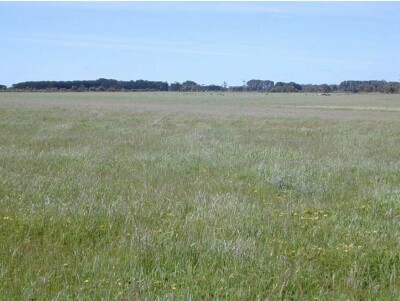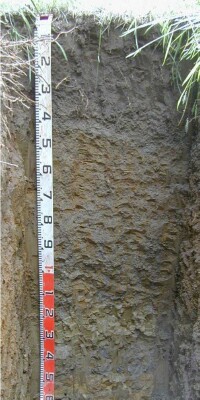GHF14d
Location: Macarthur
Australian Soil Classification: Melacic, Dutrophic, Grey KUROSOL (thick surface horizons)
General Landscape Description: Undulating rises
Site Description: North west facing slope
Land Unit: Byaduk basalts
Geology: Quaternary basalt
General Land Unit Description: This land unit is a complex unit of steep slopes leading to drainage lines and gently undulating plains leading to the slopes, south east of Branxholme. The soils on the slopes leading to the drainage lines tend to be shallower than those on the plains. The soils on the plains commonly have a sandy topsoil with a bleached A2 horizon over a clay subsoil. A co-dominant soil type is a soil type lacking the sandy topsoil and tends to have a gradual increase in clay (Dermosol) similar to this site. These soils are intermixed with Sodosols.

Soil Profile Morphology
Surface
| A1 | 0-35 cm | Very dark greyish brown (10YR3/2) sandy clay loam; weak polyhedral structure (20-50 mm) parting to weak polyhedral structure (5-10 mm); weak consistence when moderately moist; common very fine macropores; areal porosity 0.1%; many medium roots; clear and wavy transition to:
|  |
| A2 | 35-45 cm | Dark grey (10YR4/1) sandy clay loam; unable to assess structure, consistence or porosity due to very many segregations present; moderately moist; very many medium ferruginous nodules; common fine roots; abrupt and wavy transition to: | |
| Subsoil |
| ||
| B21 | 45-85 cm | Dark greyish brown (10YR4/2) with common medium faint strong brown (7.5YR5/6) mottles, medium heavy clay; weak polyhedral structure (20-50 mm); firm consistence when moderately moist; few medium ferruginous nodules; common very fine macropores; areal porosity 0.2%; few fine roots; diffuse and smooth transition to:
| |
| B22 | 85-120 cm | Grey (10YR5/1) with common medium distinct strong brown (7.5YR5/6) mottles, medium heavy clay; weak polyhedral structure (20-50 mm) parting to weak polyhedral structure (5-10 mm); firm consistence when moderately moist; very few medium ferruginous nodules; many very fine macropores; areal porosity 0.4%; few very fine roots; diffuse and smooth transition to:
| |
| B23 | 120-150 cm | Olive (5Y5/3) with common medium faint yellowish brown (10YR5/6) mottles, heavy clay; moderate angular blocky structure (50-100 mm) parting to weak polyhedral structure (5-10 mm); very firm consistence when moist; few very fine macropores; areal porosity 0.01%; few very fine roots.
| |
| C | 150-170 cm | Yellow (5Y7/6) with many coarse faint olive yellow (2.5YR6/6) mottles, light clay; massive (brittle) structure; firm consistence when moderately moist; few very fine macropores; areal porosity 0.01%; few very fine roots.
| |
| 170-200 cm | Similar to above, but an impeding layer at 200 cm, harder than C layer. Few remnant roots appear to have made their way through cracks in the weathering basalt rock. |
Profile Described By: Ian Sergeant, Paul Feikema and Martin Clark (October 2000)


